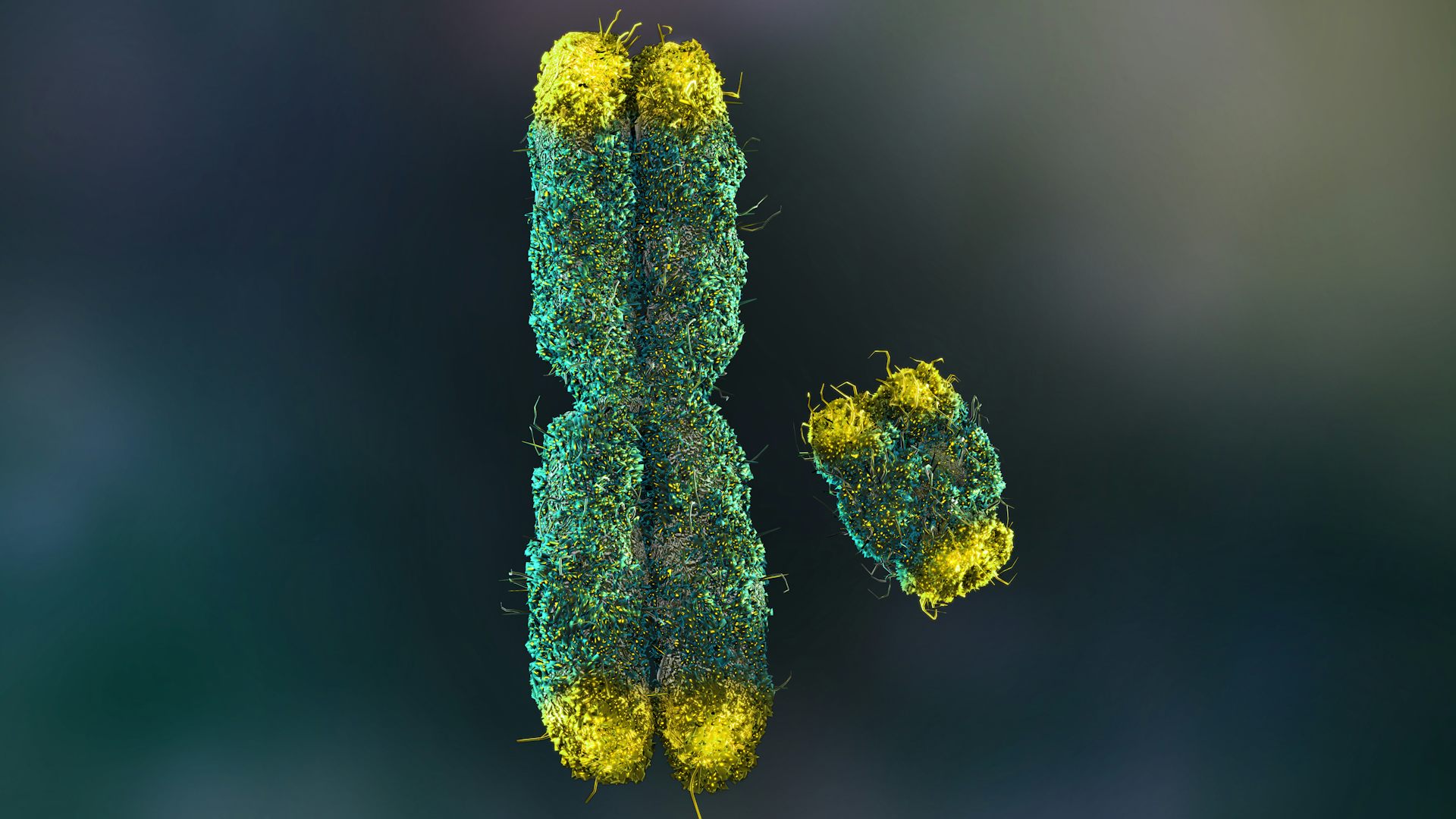
Northern mole vole, Ellobius talpinus.
Males have lost their Y chromosome
Males have lost their Y chromosome
Credit: Mikhail Kolesnikov and Marina Korobchenko), Free Software Foundation
And yet that appears to be the result of the current XY chromosomes method used by all mammals except the monotremes and a few exceptional rodents of which more later. The problem is that the Y chromosome, which is carried by males, is a degenerate and degenerating chromosome, unlike its sex-determining pair, the X Chromosome, of which females have two copies.
Over time, almost all the genes formerly carried by the Y chromosome have been lost, so, unlike the X Chromosome with about 900 genes, the Y chromosome in humans only has 55 genes and a lot of junk DNA that does nothing at all. The platypus, on the other hand, in which the X and Y chromosomes are perfectly normal paired chromosomes like all the other mammalian chromosomes, both pairs have the full complement of genes. (Sex determination in platypuses is more like that of birds and involves other chromosome pairs). Se we can deduce that in the 166 million years since humans and platypuses diverged from a common ancestor, the Y chromosome has lost 845 genes. If this rate of loss is projected into the future, the human Y chromosome will disappear in 11 million years.
Why does the Y Chromosome tend to degenerate and lose genes if this is disadvantageous? The answer is connected to the way normal chromosomes get rid of deleterious mutations and unwanted intrusions of junk 'jumping genes', and one of the advantages of sexual reproduction - they replace the unwanted stuff for the good stuff on the other one of the pair. However, the Y chromosome has no pair, so is stuck with mutations and junk. Meanwhile, functional genes can migrate to other chromosomes, so the Y chromosome tends to lose quality and quantity over time.
Degradation is typical of all sex chromosome systems. Acquisition of a gene that determines sex is the kiss of death for a chromosome, because other genes nearby on the Y evolve a male-specific function, and these genes are kept together by suppressing exchange with the X.
This means that the Y can’t get rid of mutations or deletions or invading junk DNA by swapping good bits with the X.
The poor Y chromosome is also at a disadvantage because it is in the testis every generation. This is a dangerous place to be because cells must divide many times to make sperm, so mutations are much more frequent.
Evolution, which has no way of looking into the future to see the long-term effects of a utilitarian process came up with a method of sex determination in mammals that had ultimate failure built into it - something that no omniscient designer would do, unless failure was its ultimate goal.
Why does that matter?
It matters because the Y chromosome has an essential gene, known as SRY which plays a vital role in sex determinism. SRY is activated at about 12 weeks into the development of the human embryo and stimulates the activity of another gene, known as SOX9, which controls the development of a male foetus. This gene is located on a different chromosome. So, with no Y Chromosome, there would be no males and no humans.
Unless, and this appears to be a matter of pure chance, as in some species of mole voles of eastern Europe and the spiny rats of Japan, which have already lost their Y chromosomes, a new method of sex determination evolves. In the males of these rodents, the SOX9 gene is activated by a section of the DNA adjacent to It, which seems to have been duplicated at some time in the species' evolution. This region is analogous to that found in mice, in which it has no function.
So, although it might appear that the absence of Y in males is the sex-determination mechanism in these rodents, it is actually the presence of a chance duplication on a different chromosome altogether. So much for the Creationist insistence that all mutations are deleterious! What could be more advantageous than a mutation that keeps the species from going extinct? Note too that this is an example of new genetic information arising by DNA duplication – something that Creationists dogma says can’t happen.
The Following article by Jenny Groves, Distinguished Professor of Genetics and Vice Chancellor's Fellow at La Trobe University, Australia explains how these rodents have compensated for their lost Y chromosomes. It is reprinted from The Conversation under a Creative Commons license, reformatted for stylistic consistency. The original article can be read here:

Men are slowly losing their Y chromosome, but a new sex gene discovery in spiny rats brings hope for humanity

X and Y chromosome.
Credit: Nathan Devery/Shutterstock
Jenny Graves, La Trobe University
The sex of human and other mammal babies is decided by a male-determining gene on the Y chromosome. But the human Y chromosome is degenerating and may disappear in a few million years, leading to our extinction unless we evolve a new sex gene.
The good news is two branches of rodents have already lost their Y chromosome and have lived to tell the tale.
A new paper in Proceedings of the National Academy of Science shows how the spiny rat has evolved a new male-determining gene.
How the Y chromosome determines human sex
In humans, as in other mammals, females have two X chromosomes and males have a single X and a puny little chromosome called Y. The names have nothing to do with their shape; the X stood for “unknown”.
The X contains about 900 genes that do all sorts of jobs unrelated to sex. But the Y contains few genes (about 55) and a lot of non-coding DNA – simple repetitive DNA that doesn’t seem to do anything.
But the Y chromosome packs a punch because it contains an all-important gene that kick-starts male development in the embryo. At about 12 weeks after conception, this master gene switches on others that regulate the development of a testis. The embryonic testis makes male hormones (testosterone and its derivatives), which ensures the baby develops as a boy.
This master sex gene was identified as SRY (sex region on the Y) in 1990. It works by triggering a genetic pathway starting with a gene called SOX9 which is key for male determination in all vertebrates, although it does not lie on sex chromosomes.
The disappearing Y
Most mammals have an X and Y chromosome similar to ours; an X with lots of genes, and a Y with SRY plus a few others. This system comes with problems because of the unequal dosage of X genes in males and females.
How did such a weird system evolve? The surprising finding is that Australia’s platypus has completely different sex chromosomes, more like those of birds.
In platypus, the XY pair is just an ordinary chromosome, with two equal members. This suggests the mammal X and Y were an ordinary pair of chromosomes not that long ago.
In turn, this must mean the Y chromosome has lost 900–55 active genes over the 166 million years that humans and platypus have been evolving separately. That’s a loss of about five genes per million years. At this rate, the last 55 genes will be gone in 11 million years.
Our claim of the imminent demise of the human Y created a furore, and to this day there are claims and counterclaims about the expected lifetime of our Y chromosome – estimates between infinity and a few thousand years
Rodents with no Y chromosome
The good news is we know of two rodent lineages that have already lost their Y chromosome – and are still surviving.
The mole voles of eastern Europe and the spiny rats of Japan each boast some species in which the Y chromosome, and SRY, have completely disappeared. The X chromosome remains, in a single or double dose in both sexes.

The Amami spiny rat (Tokudaia osimensis) is endemic to the Japanese island of Amami Ōshima.
Credit: Asato Kuroiwa
Kuroiwa’s team discovered most of the genes on the Y of spiny rats had been relocated to other chromosomes. But she found no sign of SRY, nor the gene that substitutes for it.

Asato Kuroiwa leads the lab that discovered the ‘new’ sex determination gene in spiny rats.
Credit: Asato Kuroiwa
What they discovered was a tiny difference near the key sex gene SOX9, on chromosome 3 of the spiny rat. A small duplication (only 17,000 base pairs out of more than 3 billion) was present in all males and no females.
They suggest this small bit of duplicated DNA contains the switch that normally turns on SOX9 in response to SRY. When they introduced this duplication into mice, they found that it boosts SOX9 activity, so the change could allow SOX9 to work without SRY.
What this means for the future of men
The imminent – evolutionarily speaking – disappearance of the human Y chromosome has elicited speculation about our future.
Some lizards and snakes are female-only species and can make eggs out of their own genes via what’s known as parthenogenesis. But this can’t happen in humans or other mammals because we have at least 30 crucial “imprinted” genes that work only if they come from the father via sperm.
To reproduce, we need sperm and we need men, meaning that the end of the Y chromosome could herald the extinction of the human race.
The new finding supports an alternative possibility – that humans can evolve a new sex determining gene. Phew!
However, evolution of a new sex determining gene comes with risks. What if more than one new system evolves in different parts of the world?
A “war” of the sex genes could lead to the separation of new species, which is exactly what has happened with mole voles and spiny rats.
So, if someone visited Earth in 11 million years, they might find no humans – or several different human species, kept apart by their different sex determination systems.
Significance
The evolution of differentiated sex chromosomes has been intensively studied over many decades to address questions, not only about the sex-determining mechanism, but also on the genetic changes to sex chromosomes. A crucial question concerns sex chromosome turnover, whereby a novel sex gene defines a new pair of sex chromosomes, leading to rapid degradation of the sex-specific element. Mammals possess an extremely stable XY chromosome system, in which the Y has almost completely degraded. Exceptional mammals that have recently lost this degraded Y are of unique value for studies of the process of sex chromosome turnover in mammals. Our findings open the way to investigating Y-loss and the earliest evolutionary changes that repurposed an autosome into a new sex chromosome.
Abstract
Mammalian sex chromosomes are highly conserved, and sex is determined by SRY on the Y chromosome. Two exceptional rodent groups in which some species lack a Y chromosome and Sry offer insights into how novel sex genes can arise and replace Sry, leading to sex chromosome turnover. However, intensive study over three decades has failed to reveal the identity of novel sex genes in either of these lineages. We here report our discovery of a male-specific duplication of an enhancer of Sox9 in the Amami spiny rat Tokudaia osimensis, in which males and females have only a single X chromosome (XO/XO) and the Y chromosome and Sry are completely lost. We performed a comprehensive survey to detect sex-specific genomic regions in the spiny rat. Sex-related genomic differences were limited to a male-specific duplication of a 17-kb unit located 430 kb upstream of Sox9 on an autosome. Hi-C analysis using male spiny rat cells showed the duplicated region has potential chromatin interaction with Sox9. The duplicated unit harbored a 1,262-bp element homologous to mouse enhancer 14 (Enh14), a candidate Sox9 enhancer that is functionally redundant in mice. Transgenic reporter mice showed that the spiny rat Enh14 can function as an embryonic testis enhancer in mice. Embryonic gonads of XX mice in which Enh14 was replaced by the duplicated spiny rat Enh14 showed increased Sox9 expression and decreased Foxl2 expression. We propose that male-specific duplication of this Sox9 enhancer substituted for Sry function, defining a novel Y chromosome in the spiny rat.
Terao, Miho; Ogawa, Yuya; Takada, Shuji; Kajitani, Rei; Okuno, Miki; Mochimaru, Yuta; Matsuoka, Kentaro; Itoh, Takehiko; Toyoda, Atsushi; Kono, Tomohiro; Jogahara, Takamichi; Mizushima, Shusei; Kuroiwa, Asato (2022)
Turnover of mammal sex chromosomes in the Sry-deficient Amami spiny rat is due to male-specific upregulation of Sox9
Proceedings of the National Academy of Sciences (PNAS); 119(49), e2211574119. DOI: 10.1073/pnas.2211574119
Copyright: © 2022 The authors.
Published by PNAS Open access.
Reprinted under a Creative Commons Attribution-NonCommercial-NoDerivatives License 4.0 (CC BY-NC-ND).


No comments :
Post a Comment
Obscene, threatening or obnoxious messages, preaching, abuse and spam will be removed, as will anything by known Internet trolls and stalkers, by known sock-puppet accounts and anything not connected with the post,
A claim made without evidence can be dismissed without evidence. Remember: your opinion is not an established fact unless corroborated.